Your browser does not fully support modern features. Please upgrade for a smoother experience.

Submitted Successfully!
Thank you for your contribution! You can also upload a video entry or images related to this topic.
For video creation, please contact our Academic Video Service.
| Version | Summary | Created by | Modification | Content Size | Created at | Operation |
|---|---|---|---|---|---|---|
| 1 | Marta Isabela Fernandes Oliveira | -- | 1715 | 2023-06-29 11:19:26 | | | |
| 2 | Jason Zhu | Meta information modification | 1715 | 2023-06-30 07:26:59 | | |
Video Upload Options
We provide professional Academic Video Service to translate complex research into visually appealing presentations. Would you like to try it?
Cite
If you have any further questions, please contact Encyclopedia Editorial Office.
Oliveira, M.F.; Mendonça, P.; Tenpierik, M.; Santiago, P.; Silva, J.F.; Silva, L.T. Shading Calculation Methods and Regulation Simplifications. Encyclopedia. Available online: https://encyclopedia.pub/entry/46210 (accessed on 13 January 2026).
Oliveira MF, Mendonça P, Tenpierik M, Santiago P, Silva JF, Silva LT. Shading Calculation Methods and Regulation Simplifications. Encyclopedia. Available at: https://encyclopedia.pub/entry/46210. Accessed January 13, 2026.
Oliveira, Marta Fernandes, Paulo Mendonça, Martin Tenpierik, Pedro Santiago, José F. Silva, Lígia Torres Silva. "Shading Calculation Methods and Regulation Simplifications" Encyclopedia, https://encyclopedia.pub/entry/46210 (accessed January 13, 2026).
Oliveira, M.F., Mendonça, P., Tenpierik, M., Santiago, P., Silva, J.F., & Silva, L.T. (2023, June 29). Shading Calculation Methods and Regulation Simplifications. In Encyclopedia. https://encyclopedia.pub/entry/46210
Oliveira, Marta Fernandes, et al. "Shading Calculation Methods and Regulation Simplifications." Encyclopedia. Web. 29 June, 2023.
Copy Citation
One of the “Goals of the United Nations 2030 Agenda for Sustainable Development” is to ensure access to affordable, reliable, sustainable and modern energy for all (SDG7). Reducing the energy demand of buildings and prioritising urban forms that reconcile energy gains simultaneously with building/energy regulations could be one solution to achieve the goal. The European Union applies a methodology to calculate the energy performance of buildings according to the common general framework determined in Annex I of the European Directive 2010/31/EU, which determines the rules regarding the formulation of the calculation used to determine the energy performance of buildings. The implementation of the Energy Performance of Buildings Directive (EPBD) aims to develop a common strategy towards achieving nearly zero-energy buildings (NzEB) from 2020 onwards.
solar shading
political-legislative premises
shading calculation methods
1. Introduction
One of the “Goals of the United Nations 2030 Agenda for Sustainable Development” is to ensure access to affordable, reliable, sustainable and modern energy for all (SDG7) [1]. Reducing the energy demand of buildings and prioritising urban forms that reconcile energy gains simultaneously with building/energy regulations could be one solution to achieve the goal. The European Union applies a methodology to calculate the energy performance of buildings according to the common general framework determined in Annex I of the European Directive 2010/31/EU, which determines the rules regarding the formulation of the calculation used to determine the energy performance of buildings. The implementation of the Energy Performance of Buildings Directive (EPBD) aims to develop a common strategy towards achieving nearly zero-energy buildings (NzEB) from 2020 onwards [2][3].
2. Discussion of the Gaps of Thermal Regulation in Portugal, Compromising the Angles of Obstruction
The Portuguese thermal regulation strategy produces identical outcomes for circumstances that are in fact distinct. The reason for this is that the method for calculating the shading factor ignores the impacts of the distance from the shading system to the glazed space and instead bases its calculation on the angle of obstruction, measured from the middle of the window facade. It follows that the regulation assigns the same shading correction factor for two situations with the same angle but different distances from the skylight to the window, resulting in solar gains with equal values (if in all other respects, the two situations are identical), even though reality demonstrates that the two situations can be different.
In the Portuguese context, the case study carried out by Silva and Henriques [4] is an example of the discrepancy of angles and mode of calculation that the Portuguese thermal regulation defines. They select a general case of a south-facing glass facade and depict the shadow masks created by shading systems with the same shading angle (α) “30°, 45°,60°” but at various distances from the window facade and the horizontal shading system. The analysis was conducted using a latitude of 39°N, which is the value recommended by Portuguese thermal regulation to represent the territories of the mainland and the Azores, as can be seen in Table 1.
Table 1. Shading schemes with identical α angles and distinct l’ distances and proposed angles by Silva and Henriques to be used in determining the shading factor for elements (dark grey represents total span shading and light grey represents the Partial shade of the span). Source: Silva and Henriques [4].
| Shading Schemes with Identical α Angles and Distinct l’ Distances | Shadow Masks South Facing Facade θ = 30° | Shadow Masks South Facing Facade, θ = 45° | Shadow Masks South Facing Facade, θ = 60° |
|---|---|---|---|
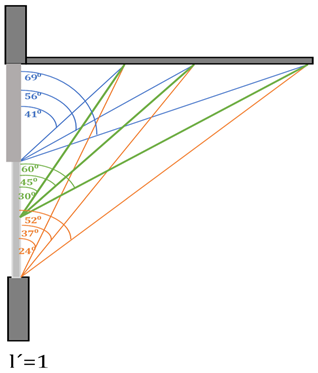 |
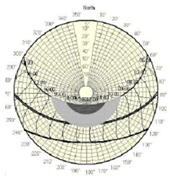 |
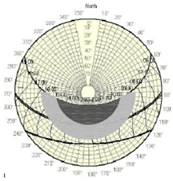 |
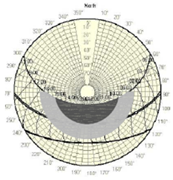 |
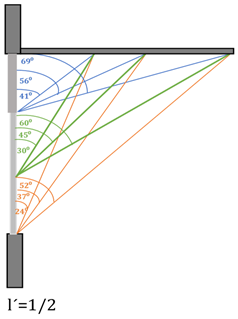 |
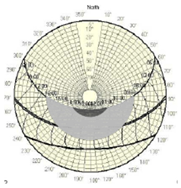 |
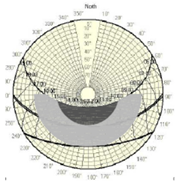 |
 |
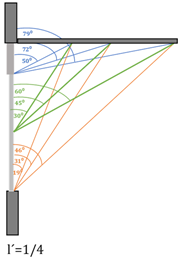 |
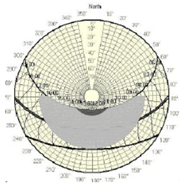 |
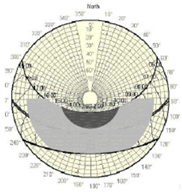 |
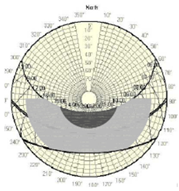 |
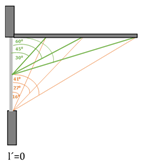 |
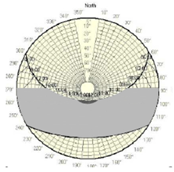 |
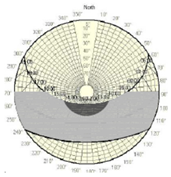 |
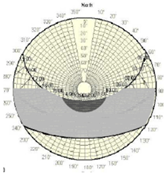 |
| Proposed angles by Silva and Henriques (2012) to be used in determining the shading factor | |||
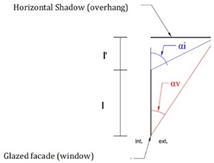 |
|||
Silva and Henriques [4] found, by analysing the three obstruction angles, that with a greater length between the horizontal element and the span (l’) during the cooling season, the facade will be completely shaded. Additionally, the time period of the partial shading of the glazed facade will be shorter the longer the distance (l’), particularly during the heating season.
This means that for a south-facing facade, at the same angle “θ” (former “α”), the larger the distance between the horizontal element and the glazed opening, the bigger the solar gains in the winter and the lower the gains in the summer, helping to reduce energy use for air conditioning and increasing a building’s energy efficiency.
Since the shading factor is solely calculated using the angle “θ” which ignores the distance from the horizontal element to the window gap (l’), the technique for determining solar gains through the window from the Portuguese regulation does not take this fact into account.
Silva and Henriques [4] state that existing regulations should take into account two angles designated as αi and αv. They base their argument on the idea that a south-facing glazed facade does not shade itself at solar noon as long as the height of the sun is less than an angle of 90°- αi. However, if the height of the sun is higher than the 90°-αv angle, complete shading of the glazed facade is obtained. According to the method for dimensioning horizontal shading elements for south-oriented facades, for a 39° N latitude, all windows should be at a significant angle in the shade at solar noon for a significant portion of the cooling season and at a significant angle (it should be αv = 21°) in the sun for a significant portion of the heating season (it should be αi = 57°).
3. Discussion of the Gaps in Thermal Regulation in Portugal, Compromising Calculation Periods
As in the previous example, the proposal presented corresponds to an omission in the Portuguese thermal regulation, where, for example, the equinoxes of the spring and autumn represent two more seasons that should be considered in a solar or/and shading evaluation to have more intermediate variables for the simulation of the shading computation. Because of its impact, either by omission or by excess, it can lead to design decisions with high energy and construction costs by not taking this factor into consideration.
The duration of the heating season differs according to the location where the study is conducted. In general, the longer the season lasts, the further north people are in the country. According to Order (extract) No. 15793-F/2013, the heating season for the city of Viana do Castelo lasts 6.3 months, beginning with the first of ten consecutive days with an average daily temperature below 15 °C and in agreement with the climate files of the region of the last 30 years. It was concluded that the heating season is 6.3 months. In terms of the cooling season, Order (extract) No. 15793-F/2013 reiterates that it lasts four months, from 1 June to 30 September, regardless of the year or region of the nation [5].
In the Portuguese climatic pattern, the energy needed to cool buildings in the summer is significantly less than that required to heat them in the winter [6][7][8]. The solar height regulates the incidence of radiation on the facades; in the summer, it significantly reduces the conditioning of the urban form in terms of facade shade, nearly ensuring their entire exposure during the daytime period. Because the sun is lower in the sky in the winter, it accentuates the relationship between the shading of the facades and the urban environment.
For the shading calculation, the adopted methodology was the modelling of the building and its urban context including the block where it is inserted, the terrain with its topography and existing buildings that border the surrounding streets. The modulation was made using a BIM (Building Information Modelling) program (Archicad) that allowed articulation with Grasshopper 3D—a plugin for Rhino 3D, which is the main parametric modelling tool [9][10][11].
Energy-related simulations are based on the case from Energy Plus Weather Format (Epw), the file is validated with the INETI Synthetic data for Portugal and by the public Portuguese Instituto de Meteorologia (Institute of Meteorology). Ladybug is a Grasshopper plugin that can simulate and create building envelopes for sun and shadow studies [12][13][14]. The case study used Ladybug to define the components of solar radiation analysis (volumes and geometries) so that the object of analysis is both the object and the context (surroundings) [12][15][16].
The demonstrative case study consists of a multi-family residential building located in Viana do Castelo, a city in the north of Portugal, and the legislation identifies its location as Climate Zones I1 and V1 (Winter 1 and Summer 1). The urban context is a historical settlement with narrow streets and buildings with an average height of three floors. The eastern, western and northern quadrants are consolidated with pre-existing construction, while the southern quadrant is more open with the presence of notable buildings such as a chapel. The building presents a closed block configuration with interior courtyards. The height is similar to the surrounding area.
The analyses were performed for four specific dates of the year, the two solstices and the two equinoxes. It can be observed that in terms of different hours of the day, the shadows in the autumn and spring equinoxes are identical. The facade presented is the south-west-facing façade, and, on the solstices, the shadows are very distinct, as can be seen in Table 2.
Table 2. Solar and shadow study in different periods of the year in a block of the city of Viana do Castelo.
| Periods of the Year That Must be Taken into Account when Calculating Shading | ||||
|---|---|---|---|---|
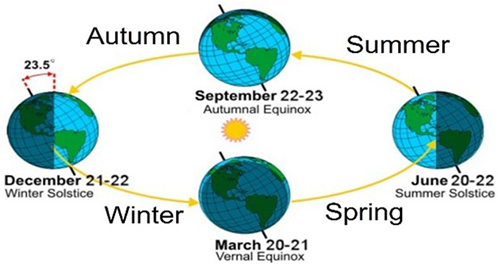 Figure Adopted from The National Weather Service (NWS) |
||||
| Hours | Autumnal Equinox | Winter Solstice | Vernal Equinox | Summer Solstice |
| 12 h–13 h |  |
 |
 |
 |
| 14 h–15 h | 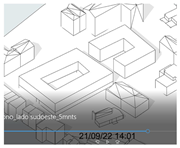 |
 |
 |
 |
| 16 h–17 h | 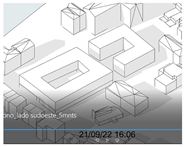 |
 |
 |
 |
| 18 h–19 h |  |
 |
 |
 |
| Sun hours of each day | ||||
 |
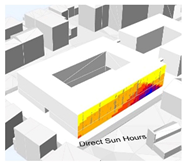 |
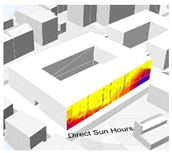 |
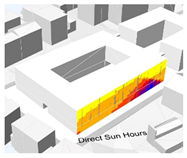 |
 |
The results of the analysis present a clear difference between the four times of the year concerning solar availability on various parts of the facade (Table 2). The area facing the nearest building has less solar radiation than the rest during the winter solstice. On the summer solstice, the same building only casts a shadow on the lower floor of the facade. However, during the equinoxes, the facade clearly shows a different area subject to a shadow. The number of sun hours changes considerably throughout the four periods of the year.
The analysis shows that if the intermediate seasons are not calculated, the solar analysis and the shading calculation will be very different from reality. However, the Portuguese thermal law considers that only the heating season and the cooling season, as mentioned above, should be calculated, and it is a weighted average between the mentioned periods. Thus, as expected, it is not accurate to consider it representative of a heating season or cooling season when so many differences in solar radiation or shade production occur.
References
- Development Goals|United Nations Development Programme. Available online: https://www.undp.org/sustainable-development-goals (accessed on 3 April 2023).
- Aelenei, L. NZEB, Passive Solutions and Integration in Façades. 2022. Available online: https://www.lneg.pt/wp-content/uploads/2022/05/laura-aelenei-4-maio-2022.pdf (accessed on 4 May 2022).
- Silva, S.M.; Mateus, R.; Marques, L.; Ramos, M.; Almeida, M. Contribution of the Solar Systems to the NZEB and ZEB Design Concept in Portugal—Energy, Economics and Environmental Life Cycle Analysis. Sol. Energy Mater. Sol. Cells 2016, 156, 59–74.
- Silva, J.J.C.; Henriques, P.M.C. Proposal for a New Methodology for Calculating the Shading Factor of Glazed Spans by Horizontal Elements. Construction Congress 2012, Ed.; University of Coimbra: Coimbra, Portugal, 2012; pp. 1–9.
- Order (Extract) No. 15793-F/2013; Portugal. 2013, pp. 35088-(26)–35088-(31). Available online: https://dre.pt/dre/detalhe/despacho-extrato/15793-f-2013-2975219 (accessed on 5 April 2023).
- Dagher, S.; Akhozheya, B.; Slimani, H. Energy Analysis Studying the Effect of Solar Shading on Daylight Factors and Cooling Hours in an Extreme Weather. Energy Rep. 2022, 8, 443–448.
- Brito, M.C.; Redweik, P.; Catita, C.; Freitas, S.; Santos, M. 3D Solar Potential in the Urban Environment: A Case Study in Lisbon. Energies 2019, 12, 3457.
- Coutinho, H.M.S. Relation between Urban Form and Solar Radiation on Buildings. Master’s Thesis, Civil and Environmental Engineering, Higher School of Technology and Management, Polytechnic Institute of Viana do Castelo, Viana do Castelo, Portugal, 2018. Available online: https://repositorio.ipvc.pt/handle/2 (accessed on 2 May 2023).
- Archicad—BIM. Available online: https://graphisoft.com/solutions/archicad#archicad (accessed on 15 May 2023).
- Grasshopper—Algorithmic Modeling for Rhino. Available online: https://www.grasshopper3d.com/ (accessed on 14 May 2023).
- Rhino 6 for Windows and Mac. Available online: https://www.rhino3d.com/ (accessed on 14 June 2020).
- Ouria, M. Solar Energy Potential According to Climatic and Geometrical Parameters of Cities and Buildings: A Case-Study from Tabriz City- Iran. Urban Clim. 2019, 28, 100469.
- Elwy, I.; Ibrahim, Y.; Fahmy, M.; Mahdy, M. Outdoor Microclimatic Validation for Hybrid Simulation Workflow in Hot Arid Climates against ENVI-Met and Field Measurements. Energy Procedia 2018, 153, 29–34.
- Kharvari, F. An Empirical Validation of Daylighting Tools: Assessing Radiance Parameters and Simulation Settings in Ladybug and Honeybee against Field Measurements. Sol. Energy 2020, 207, 1021–1036.
- Wen, J.; Xie, Y.; Yang, S.; Yu, J.; Lin, B. Study of Surrounding Buildings’ Shading Effect on Solar Radiation through Windows in Different Climates. Sustain. Cities Soc. 2022, 86, 104143.
- Forouzandeh, N.; Tahsildoost, M.; Zomorodian, Z.S. A Review of Web-Based Building Energy Analysis Applications. J. Clean. Prod. 2021, 306, 127251.
More
Information
Subjects:
Engineering, Civil
Contributors
MDPI registered users' name will be linked to their SciProfiles pages. To register with us, please refer to https://encyclopedia.pub/register
:
View Times:
729
Revisions:
2 times
(View History)
Update Date:
30 Jun 2023
Notice
You are not a member of the advisory board for this topic. If you want to update advisory board member profile, please contact office@encyclopedia.pub.
OK
Confirm
Only members of the Encyclopedia advisory board for this topic are allowed to note entries. Would you like to become an advisory board member of the Encyclopedia?
Yes
No
${ textCharacter }/${ maxCharacter }
Submit
Cancel
Back
Comments
${ item }
|
More
No more~
There is no comment~
${ textCharacter }/${ maxCharacter }
Submit
Cancel
${ selectedItem.replyTextCharacter }/${ selectedItem.replyMaxCharacter }
Submit
Cancel
Confirm
Are you sure to Delete?
Yes
No




